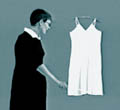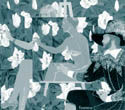 |





FEMININITY'S REDRESS
March-April 2002
Antoshina Tatiana,
Chuykova Masha,
Kotyol Nina,
Lukashevich Alina,
Domnitch Evelina,
Egorova Olga (Tsaplya),
Frolova Zoya,
Korennova Elena,
Zaretskaya Nina,
Liberman Tanja
THE C.A.S.E. MUSEUM OF CONTEMPORARY RUSSIAN ART
80 GRAND STREET, JERSEY CITY, NJ 07302
TEL (201) 332-5200
March 23 – April 20
CONTACTS: OLGA P. BOLHUIS, (201) 521-0559
JANE GOLDBERG, (201) 434-6629
The C.A.S.E. MUSEUM HOSTS SEVENTH ANNUAL WOMEN'S SHOW
The C.A.S.E. Museum of Contemporary Russian Art is hosting its Seventh Annual Women’s Show "Femininity’s Redress", an international exhibition of women artists from Russia and the United States. The show opens with a reception March 23, 2002.
The C.A.S.E. Museum was founded in 1980 to provide a forum for artists forbidden to exhibit in the Soviet Union because their work did not fit into the Soviet ideal of public state art. The Museum’s new primary focus is to bring to the attention of the American public talented artists with origins in the former Soviet Union. Additionally, with only 4% of museum acquisitions nationwide being works by women, the Annual Women’s Show provides women artists with the opportunity to showcase their work in a museum setting.
Visitors to the Museum will be able to see works by women artists from both Russia and the United States. The goal of this project is to introduce to American audiences art of women artists united by mutual origin – all of them born and raised in the former Soviet Union. Furthermore, the exhibition presents the viewpoint of artists who are connected to the Russian women’s movement, which differs from its western counterparts. This movement, while absorbing international experience in a constructive way, is trying to find its voice. These artists raise questions concerning gender without confining themselves to nods of approval towards formal emancipation; they consider female themes in the context of a more advanced discourse on femininity, correspondingly representing it in their art.
Artists participating in the show:
Tania Antoshina – Moscow
Olga Yegorova, "Tsaplya" – Saint Petersburg
Masha Chuikova – Moscow
Evelina Domnitch – New York
Tanya Hengstler – Moscow/New York
Elena Korennova – New York
Nina Kotel – Moscow
Tania Liberman – Moscow
Zoya Frolova – Jersey City
Alina Lukatsevich – New York
Nina Zaretskaya – Moscow/Jersey City
Curator: Dr. Nina Zaretskaya, founding director of Art Media Center "TV Gallery" in Moscow.
The show opens with a reception March 23, 2002, 7 –10 p.m. The exhibition closes April 20, 2002. Hours are Friday, Saturday and Sunday 12 to 5 p.m. and by appointment. The Museum is located at 80 Grand Street in the Historical Paulus Hook neighborhood in downtown Jersey City. While donations are greatly appreciated, there is no admission charge.
Directions: From Path Grove Street Station east on Christopher Columbus Drive, right on Washington Street and left on Grand Street. From Manhattan, take Holland tunnel to Jersey City, left on Luis Marin Blvd and left on Grand Street.
For a view of select images from the collection visit: http://www.portablepalace.com/nina/press.html
For additional information please contact The C.A.S.E. Museum at 201 332 5200.
The project is realized with the assistance of Art Media Center "TV Gallery" and the support of The Network Women's Program of the Open Society Institute (Soros Foundation, Moscow).
# # #
FEMININITY'S REDRESS
An exhibition of women artists from Russia and the USA
The C.A.S.E. Museum of Contemporary Russian Art, Jersey City, NJ
March 23 – April 20, 2002
FEMININITY, AN ETERNAL IRONY OF PUBLIC
Hegel
The goal of this project is to introduce to American audiences art of women artists united by mutual origin – all of them, regardless of where they live now, be it in Moscow, St. Petersburg, New York or Jersey City, were born and grew up in the former Soviet Union. All of them have been brought up in one culture. This is why to a great extent they share similar views, in particular, with regard to the subject of this exhibition. The exhibition introduces to the American public the viewpoint of women artists who are connected with the Russian women's movement, which differs from its western counterparts. This movement, while absorbing international experience in a constructive way, is trying to find its own voice.
The name of our exhibition, on the one hand, refers to the polemics with some western trends of feminist theory; on the other hand, it reveals the core of the feminine factor as a universal category, which does not confine itself to either sex's physiology or gender's sociology.
What a woman could set off against her aversion to the patriarchal masculine culture? I think it should be some distinction – independence, specificity of the body, style of speaking, etc… This project represents first of all an attempt to articulate by means of contemporary art the concept of distinction, which is very important in order to build up a contemporary feminist discourse. The feminine has always had its own strategy. And it has alwa
ys been the strategy of challenge, despite all the attempts for many centuries to exclude it. There exist ancient pictures of women warriors on earthenware, vases and sarcophaguses; proud and strong women used to be berhymed since Homer’s epochs. Sagas were dedicated to them. Their figures were carved into marble and cast in bronze. Amazingly, these images of women lack any trace of the masculine. Their might is arrayed in the clothes of active femininity.
Contemporary society needs to face a sort of historical femininity's redress. At the turn of a new millennium people began speaking of the approach of the «era of the woman», and this is not just a groundless idea. Just recall the cardinal changes in women's lives in the last century. In this century women around the world achieved suffrage and became full members of government and political processes. It is now difficult to imagine that women once faced imprisonment just for coming to the polls!
Femininity is one of the most popular concepts in Russian culture. In Old Russia the role of a woman used to be traditionally much more important than in the West. Thus, the rights of women in Old Russia were stated in family law. For example, a married couple had the right to separate properties. This distinction was absolutely unknown in Western Europe, and this fact radically distinguished the social status of Russian women who were economically more independent and therefore able to play a significant role in state life. Historic resources attest to this fact. Look, for example, at Princess Olga, first ruler in Russia, who adopted Christianity. The reforms of Peter I and Ekaterina II also created conditions under which the 18th century became the age of the Russian Enlightenment. During this time, women enjoyed societal prominence and education, such as Ekaterina Dashkova, the first woman president of the Russian Science Academy. Later, during ongoing warring of the Russian Empire, women of noble families were burdened with the economics and responsibilities of domestic concerns. By the time of Soviet era Communism, a gender equality imposed by government authorities was little opposed by men who had become accustomed to a comparative equality during the long history of the country.
From the viewpoint of feminism of this kind, the distinctions between men and women became obliterated. Femininity was abolished as a phenomenon of bourgeois ideology. A woman’s role was firstly as friend or colleague, and secondly as wife and mother. However, the Soviet system proved to be a system of hidden discrimination. It was just a well-thought-out myth about men and women's equal rights in the socialist society, which in fact had an underlying patriarchy. It is remarkable then that femininity became one of the first byproducts of post-Stalin liberalization. Beginning in the 1960s, Soviet films and books celebrated the heroine alongside the hero.
In the late 1980s the ideas of western feminism reached Russia. And, again femininity was criticized in order to please foreign theories that were not well understood. Slowly, there came a realization that women possess potential abilities on parallel with those of men. Women differ in their anatomy and sexuality, as well as according to social and historical forces in their development. Contemporary Russian women are anxious to be more and more independent; they want to work in a job of their choosing, get an adequate (both in a moral and material sense) reward for their work, make independent decisions about their physiology, about giving birth and bringing up children, and around issues of marriage and divorce. At the same time women appreciate more and more their distinctions from men and insist on their right to express their selfhood. They demand that their femininity be respected and acknowledged, rather than viewing the female as something equal to the male, which we have experienced during the times of Soviet totalitarian unification. Nowadays, Russian women believe that whatever they do it will bear elements of femininity.
Lastly, it is important to note the role of Russian women in the history of visual arts. While women played a remarkable part in Russian art beginning with the avant-garde of the 1910s, the male discourse has always been the prevailing one. In the wake of groundbreaking work by female artists outside of Russia including Judy Chicago, Mariam Shapiro, Louise Bourgeois, Cindy Sherman, Rebecca Horn, Rosemarie Trockel and many other foreign colleagues, Russian women artists started to begin to explore feminist issues more and more frankly. Raising questions concerning gender without confining themselves just to making nods of approval towards formal emancipation, they consider female themes in the context of more advanced feministic discourse, correspondingly representing it in their art.
Curator – Nina Zaretskaya
video: 256 Kbps. fragment
Publications
The site has been created with the assistance of the "Open Society Institute" (Soros Foundation). Russia
|






